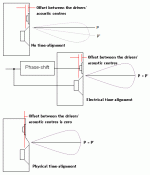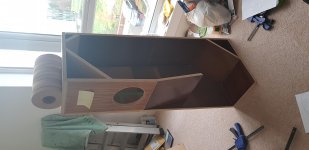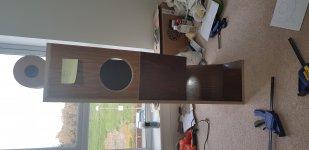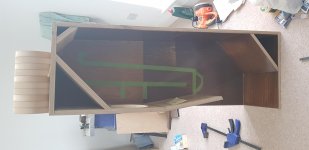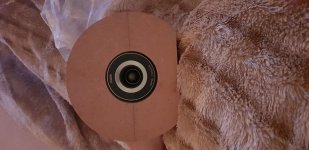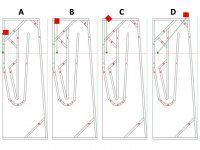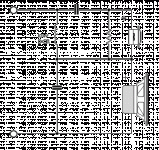Hi All - I'm a COMPLETE NOVICE - throwing myself in at the deep end by building the Dallas II's and will be using the 208ez (sigma) and T90a super tweeter.
For the T90a, I will be using an MDF 'tunnel' - purely for aesthetics (and to keep the wife happy!). This tunnel design for the tweeter is not open for debate / critique.
However, I would like to know from you guys if there is anything I should be genuinely worried about regarding phase alignment / shift? I found the attached image about phase-shift which was simple enough for even me to understand. In short - If you were me, would you look to set the super tweeter tunnel back a little so that it better aligns with the 208ez (albeit completely messing with mine and my Wife's OCD by not sitting flush with the baffle!)?
If having the T90a tunnel flush with 208ez is going to cause no-to-very little issue, then I'm keeping it as planned!!!
I've also attached some photos of pretty much where i'd got to with the Dallas II's so you can see what I'm aiming for here.
Many thanks!
For the T90a, I will be using an MDF 'tunnel' - purely for aesthetics (and to keep the wife happy!). This tunnel design for the tweeter is not open for debate / critique.
However, I would like to know from you guys if there is anything I should be genuinely worried about regarding phase alignment / shift? I found the attached image about phase-shift which was simple enough for even me to understand. In short - If you were me, would you look to set the super tweeter tunnel back a little so that it better aligns with the 208ez (albeit completely messing with mine and my Wife's OCD by not sitting flush with the baffle!)?
If having the T90a tunnel flush with 208ez is going to cause no-to-very little issue, then I'm keeping it as planned!!!
I've also attached some photos of pretty much where i'd got to with the Dallas II's so you can see what I'm aiming for here.
Many thanks!
Attachments
Well, the acoustical centre of the voice coils (a somewhat nebulous concept) should be physically aligned if you don't want to do it electrically.
I'm not going to critique the design of your 'tunnel' for the T90a, other than say however that if you're going to stick it in that thing, in all honesty you'd be better off not bothering with it at all. We're not talking 'a bit of a compromise' here; we're talking affecting behaviour so badly that it will almost certainly sound worse than if you do without.
I'm not going to critique the design of your 'tunnel' for the T90a, other than say however that if you're going to stick it in that thing, in all honesty you'd be better off not bothering with it at all. We're not talking 'a bit of a compromise' here; we're talking affecting behaviour so badly that it will almost certainly sound worse than if you do without.
Well, the acoustical centre of the voice coils (a somewhat nebulous concept) should be physically aligned if you don't want to do it electrically.
I'm not going to critique the design of your 'tunnel' for the T90a, other than say however that if you're going to stick it in that thing, in all honesty you'd be better off not bothering with it at all. We're not talking 'a bit of a compromise' here; we're talking affecting behaviour so badly that it will almost certainly sound worse than if you do without.
Appreciate you going easy on me! Why would the tweeter sound so bad in it?I thought it was better than the 2 'dowels' you get in the box which it would just sit on.
Attachments
Last edited:
That's a huge vertical center to center distance for a supertweeter.
You might be able to dial it in for one tiny sweet spot, but expect a lot of lobing if you move around at all.
If it were me, I'd think about rear firing the super tweeter or bouncing it off the ceiling.
If you really want to front fire the super tweeter, I'd think about mounting a tube in the unused space in front of and above the diagonal piece of the cabinet and putting the super tweeter in that.
You want the drivers as close as possible, and it becomes more critical the higher the crossover frequency.
You also might want to consider experimenting with a very high order crossover.
You might be able to dial it in for one tiny sweet spot, but expect a lot of lobing if you move around at all.
If it were me, I'd think about rear firing the super tweeter or bouncing it off the ceiling.
If you really want to front fire the super tweeter, I'd think about mounting a tube in the unused space in front of and above the diagonal piece of the cabinet and putting the super tweeter in that.
You want the drivers as close as possible, and it becomes more critical the higher the crossover frequency.
You also might want to consider experimenting with a very high order crossover.
Ah, well: depends. I was assuming the dome was buried deep within a tunnel along which it would radiate. If it's in effect simply mounted at the front of a long cylinder which is being used to aesthetically conceal it, that's a different story. In the former case you'd have horrendous standing waves / reflections (just try talking along a tube) so this should be avoided like the plague for HF use. In the latter case, shouldn't be a big deal. Circles aren't great for diffraction, but the T90a is horn loaded & thus relatively directional, so shouldn't be a big deal.
As noted, there's quite a distance between the drivers which isn't ideal, but you should get away with it since it's mostly just providing some assistance with harmonics, even if it doesn't look ideal on a graph.
As noted, there's quite a distance between the drivers which isn't ideal, but you should get away with it since it's mostly just providing some assistance with harmonics, even if it doesn't look ideal on a graph.
Last edited:
Ah, well: depends. I was assuming the dome was buried deep within a tunnel along which it would radiate. If it's in effect simply mounted at the front of a long cylinder which is being used to aesthetically conceal it, that's a different story. In the former case you'd have horrendous standing waves / reflections (just try talking along a tube) so this should be avoided like the plague for HF use. In the latter case, shouldn't be a big deal. Circles aren't great for diffraction, but the T90a is horn loaded & thus relatively directional, so shouldn't be a big deal.
Yes, it's definitely the latter ! you're a star - thanks for your thoughts.
What you want is a smooth waveguide expanding out while giving the tweeter the necessary setback. If you put any sharp hard edge like a (1mm even) lip, a sharp edged ridge, not to mention a tunnel (tube), it will adversely affect the sound. Carefully designed tweeter reflectors or diffraction devices (like ones used above some tweeters from SAW) can work but they are modeled with FEA to provide the required sound.
That's a huge vertical center to center distance for a supertweeter.
You might be able to dial it in for one tiny sweet spot, but expect a lot of lobing if you move around at all.
The tweeter needs to be as pysically close to the FE208 as possible. Even then the seperation will be too great to get any phase alignment but for one spot. Fortuneatly up where these will be crossed it is not overly critical.
The void above the woofer is an ideal place to put up.
The mounting cylinder, if you don’t do the right thing and abandon it, needs to have a heavy chafer/bevel on the front edges.
dave
What you want is a smooth waveguide expanding out while giving the tweeter the necessary setback.
Built into the tweeter already.
dave
The void above the woofer is an ideal place to put up.
The mounting cylinder, if you don’t do the right thing and abandon it, needs to have a heavy chafer/bevel on the front edges.
dave
Hi - Thanks for this. Which of the 4 options attached for the T90a (super tweeter) placement, would you expect would produce the best results? I have also embedded a link to a YouTube video which I found really helpful - which supports your views.
I welcome mothers' thoughts too. Thanks all.
YouTube
Attachments
Last edited:
A is least compromised in terms of position relative to the main driver.
Agreed re point-to-point distance between the two, but the Youtube video I shared gives a good case for positions B or D so as to give a good 'ambience' and not cancel out / clash with the frequencies generated by the full range driver (Fostex FE208ez).
I threw C in there as a potentially even better version of B.
As a reminder, it's the Fostex T90a super tweeter I'd be using with (probably) a 1.0 - 1.5uf cap.
YouTube
Last edited:
I defer to your superior knowledge.
I very much doubt I do have superior knowledge, mate! I'm a novice.
I'm simply going by what others have implied in this thread (and another I started a couple of years ago) about placing and / or pointing the tweeter in different places / directions. Plus the YouTube video which seemed to make sense to me.
I value your opinion so thanks for suggesting position A and giving your reason.
Do you have a view on the other positions?
Thanks again.
I like A, but i suspect that you could get the tweeter even closer than you have drawn.
The video is useful. Do note that a half-inch is a huge amount — one should be moving it by mm. And the placement of the microphone makes a huge difference. You can take the general ideas but in the end there are huge gotchas -- you have to listen to it and decide what works for you. (this guy works closely w Danny Richie and the ideas are very similar to an essay he posted on Audio Circle).
The dispersion of the tweeters he is using are way different than yours, crossing high you really want dispersion similar to the FR at the XO.
With the FE208e∑ you are talking about an XO an octave lower.
The issues with the overlap with just a cap on the tweeter can be at least partially e;iminated by increasin gthe slopes of the XO. Here is a speculative XO that i did in a thot experiement for the FE207 — the same concepts applys for you.

This puts secound order on the T and adds a 1st order to the FR, so much less overlap, and the series XO means that the 2 drivers track each other somewhat. A series XO may be a bit trickier to implement.
dave
The video is useful. Do note that a half-inch is a huge amount — one should be moving it by mm. And the placement of the microphone makes a huge difference. You can take the general ideas but in the end there are huge gotchas -- you have to listen to it and decide what works for you. (this guy works closely w Danny Richie and the ideas are very similar to an essay he posted on Audio Circle).
The dispersion of the tweeters he is using are way different than yours, crossing high you really want dispersion similar to the FR at the XO.
With the FE208e∑ you are talking about an XO an octave lower.
The issues with the overlap with just a cap on the tweeter can be at least partially e;iminated by increasin gthe slopes of the XO. Here is a speculative XO that i did in a thot experiement for the FE207 — the same concepts applys for you.
This puts secound order on the T and adds a 1st order to the FR, so much less overlap, and the series XO means that the 2 drivers track each other somewhat. A series XO may be a bit trickier to implement.
dave
Attachments
OP, if you're a complete novice as you say, then why not make the cab to spec instead of adding two drivers not designed for the Dallas, and now a crossover as well? Dunno, don't make no sense to me...
Just because I'm a novice, doesn't mean I can't have desire or ambition, pal. When did I say anything about a crossover as well?
Last edited:
That's fine have at it... But maybe it would have been nice to build it to spec as designed by Ron, then once you've actually heard it as designed which by your choice you never will, then maybe look for some tweaks to it, um pal.... :/
Ever tried being constructive instead of coming across as a sarcastic ****? Distinct difference between everyone else who's replied to me, and you.
Maybe you just bypassed the keen novice stage and jumped straight to a know it all expert.
I responded to your derogatory bs by calling me "pal" is all, which was uncalled for. And if you can read maybe you should look it all over again, as you stated yourself in your opening post that you don't know what you're doing. So all I said and asked is why are you not building the cab to spec rather than going off on your own design tangent?
So if I designed a cabinet that was specific to a driver and it worked well, then you'd come along after never hearing that design and add your own drivers and try to make all your own modifications to a design you've never heard nor understand. Make sense?, or am I still the bad guy here?
So if I designed a cabinet that was specific to a driver and it worked well, then you'd come along after never hearing that design and add your own drivers and try to make all your own modifications to a design you've never heard nor understand. Make sense?, or am I still the bad guy here?
- Status
- This old topic is closed. If you want to reopen this topic, contact a moderator using the "Report Post" button.
- Home
- Loudspeakers
- Full Range
- Dallas II build - Phase shift?
